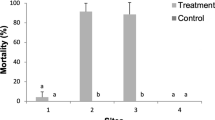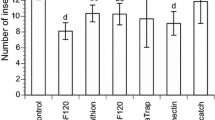Abstract
Many moth pheromones and synthetic attractants have been used to monitor or decrease pest populations. However, due to their low economic efficiencies and narrow target specificities these methods are of limited use for trapping pests in large agricultural fields. In an effort to address this problem, we selected oak (Quercus serrata) sawdust media fermented by the yeast strain Pichia anomala, and examined its ability to attract lepidopteran moth pests for mass trapping in an apple (Malus domestica) orchard. A total of 57 taxa were trapped, including 42 species of lepidopteran pests. The most frequently caught lepidopteran pests included Adoxophyes orana (40.0 ± 3.5 individuals/trap/week), Oraesia excavata (35.5 ± 2.5), and Adris tyrannus amurensis (35.5 ± 2.5). Notably, less fruit damage was recorded in the experimental orchard versus a trap-free neighboring control orchard. These results suggest that adult moths might be effectively attracted and mass captured using P. anomala-fermented oak sawdust media as bait.
Similar content being viewed by others
References
Armelle, V. and D. Silvia (2005) Changes in volatile emissions from apple trees and associated response of adult female codling moths over the fruit-growing season. J. Agric. Food Chem. 53: 4083–4090.
Sauphanor, B., P. Frank, T. Lasnier, J. F. Toubon, D. Beslay, T. Boivin, J. C. Bouvier, and M. Renou (2007) Insecticide resistance may enhance the response to a host-plant volatile kairomone for the codling moth, Cydia pomonella (L.). Naturwissenschaften 94: 449–458.
El-Sayed, A. M., V. J. Heppelthwaite, L. M. Manning, A. R. Gibb, and D. M. Suckling (2005) Volatile constituents of fermented sugar baits and their attraction to lepidopteran species. J. Agr. Food Chem. 53: 953–958.
El-Sayed, A. M., D. M. Suckling, C. H. Wearing, and J. A. Bayers (2006) Potential of mass trapping for long-term pest management and eradication of invasive species. J. Econom. Entomol. 99: 1550–1564.
Kinkorova, J. and F. Kocourek (2000) The effect of integrated pest management practices in an apple orchard on Heteroptera community structure and population dynamics. J. Appl. Entomol. 124: 381–385.
Sackett, T. E., C. M. Buddle, and C. Vincent (2007) Effects of kaolin on the composition of generalist predator assemblages and parasitism of Choristoneura rosaceana (Lep., torricidae) in apple orchards. J. Appl. Entomol. 131: 478–485.
Haynes, K. F., J. Z. Zhao, and A. Latif (1991) Identification of floral compounds from Abelia grandiflora that stimulate upwind flight in cabbage looper moths. J. Chem. Ecol. 17: 637–646.
Robards, K., P. R. Haddad, and P. E. Jackson (1994) Principles and Practice of Modern Chromatographic Methods. Academic Press, NY, USA.
Shin, Y. H. (2001) Colored illustrations of the moths of Korea. Academy Publishing Company, Seoul, Korea.
Meagher, R. L. (2002) Trapping noctuid moths with synthetic floral volatile lures. Entomol. Exp. Appl. 103: 219–226.
Landolt, P. J. (1995) Attraction of Mocis latipes (Lepidoptera: Noctuidae) to sweet baits in traps. Florida. Entomol. 78: 523–530.
Meagher, R. L. and P. Mislevy (2005) Trapping Mocis spp. (Lepidoptera: Noctuidae) adults using different attractants. Florida. Entomol. 88: 424–430.
Etschmann, M. M. W., D. Sell, and J. Schrader (2003) Screening of yeasts for the production of the aroma compound 2-phenylethanol in a molasses-based medium. Biotechnol. Lett. 25: 531–536.
Connick, W. J. and R. C. French (1991) Volatiles emitted during the sexual stage of the Canada thistle rust fungus and by thistles flowers. J. Agr. Food Chem. 39: 185–188.
Andersson, S., L. A. Nilsson, I. Groth, and G. Bergstrom (2002) Floral scents in butterfly pollinated plants: Possible convergence in chemical compositions. Bot. J. Linean Soc. 140: 129–153.
Theis, N. (2006) Fragrance of Canada thistle (Cirsium arvense) attracts both floral herbivores and pollinators. J. Chem. Ecol. 32: 917–927.
Suckling, D. M. and A. R. Gibb (2003) Use of pheromones and other attractants to combat insect incursions. pp. 153. In: S. L. Goldson and D. M. Suckling (eds). Defending a Green Oasis: The Role of Science in Biosecurity. New Zealand Plant Protection Society, Christchurch.
Author information
Authors and Affiliations
Corresponding author
Rights and permissions
About this article
Cite this article
Choi, HS., Kim, GJ. & Shin, HJ. Biocontrol of moth pests in apple orchards: Preliminary field study of application potential for mass trapping. Biotechnol Bioproc E 16, 153–157 (2011). https://doi.org/10.1007/s12257-010-0127-7
Received:
Revised:
Accepted:
Published:
Issue Date:
DOI: https://doi.org/10.1007/s12257-010-0127-7




